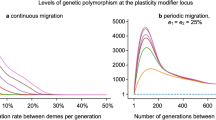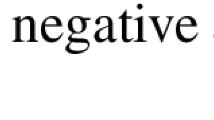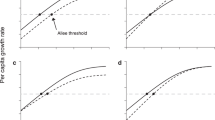Abstract
Demographic stochasticity (due to the probabilistic nature of the birth–death process) and demographic heterogeneity (between-individual differences in demographic parameters) have long been seen as factors affecting extinction risk. While demographic stochasticity can be independent of underlying species traits, demographic heterogeneity may strongly depend on phenotypic variation. However, how phenotypic variation can affect extinction risk is largely unknown. Here, I develop a stochastic metapopulation model that takes into account the effects of demographic stochasticity and phenotypic variation in the traits controlling colonization rates to assess what the effect of phenotypic variation may be on the persistence of the metapopulation. Although phenotypic variation can lead to a decrease in metapopulation persistence under some conditions, it also may lead to an increase in persistence whenever phenotypic mismatch—or the distance between the optimal trait value and the population mean—is large. This mismatch can in turn arise from a variety of ecological and evolutionary reasons, including weak selection or a recent history of invasion. Last, the effect of phenotypic variation has a deterministic component on colonization rates, and a stochastic component on persistence through colonization rates, but both are important to understand the overall effect. These results have important implications for the conservation of threatened species and management practices that may historically have overlooked phenotypic variation as unimportant noise around mean values of interest.




Similar content being viewed by others
References
Alonso D, McKane AJ (2002) Extinction dynamics in mainland-island metapopulations: an N-patch stochastic model. Bull Math Biol 64:913–958
Araújo MS, Bolnick DI, Layman CA (2011) The ecological causes of individual specialisation. Ecol Lett 14:948–958
Arroyo-Rodríguez V, Pineda E, Escobar F, Benítez-Malvido J (2009) Value of small patches in the conservation of plant-species diversity in highly fragmented rainforest. Conserv Biol 23:729–739
Bolnick DI, Amarasekare P, Araújo MS, Bürger R, Levine JM, Novak M, Rudolf VHW, Schreiber SJ, Urban MC, Vasseur DA (2011) Why intraspecific trait variation matters in community ecology. Trends Ecol Evol 26:183–192
Caswell H (2001) Matrix population models, 2nd edn. Sinauer Associates, Sunderland, Massachusetts
Caswell H (2009) Stage, age and individual stochasticity in demography. Oikos 118:1763–1782
Chesson PL (1981) Models for spatially distributed populations: the effect of within-patch variability. Theor Popul Biol 19:288–325
Conner MM, White GC (1999) Effects of individual heterogeneity in estimating the persistence of small populations. Nat Resour Model 12:109–127
Daufresne M, Lengfellner K, Sommer U (2009) Global warming benefits the small. Proc Natl Acad Sci 106:12788–12793
DeLong JP (2012) Experimental demonstration of a “rate–size” trade-off governing body size optimization. Evol Ecol Res 14:343–352
Dobzhansky T (1937) Genetics and the origin of species. Columbia University Press, New York
Engen S, Lande R, Sæther BE, Weimerskirch H (2005) Extinction in relation to demographic and environmental stochasticity in age-structured models. Math Biosci 195:210–227
Fellowes MD, Kraaijeveld AR, Godfray HC (1998) Trade-off associated with selection for increased ability to resist parasitoid attack in Drosophila melanogaster. Proc Biol Sci 265:1553–1558
Fisher RA (1930) The genetical theory of natural selection. Clarendon Press, Oxford
Fox GA (2005) Extinction risk of heterogeneous populations. Ecology 86:1191–1198
Fox GA, Kendall BE (2002) Demographic stochasticity and the variance reduction effect. Ecology 83:1928–1934
Fox GA, Kendall BE, Fitzpatrick JW, Woolfenden GE (2006) Consequences of heterogeneity in survival probability in a population of Florida scrub-jays. J Anim Ecol 75:921–927
Frank SA (2012) Natural selection. IV. The Price equation. J Evol Biol 25:1002–1019
Gates JE, Gysel LW (1978) Avian nest dispersion and fledging success in field-forest ecotones. Ecology 59:871
Gibert JP, Brassil CE (2014) Individual phenotypic variation reduces interaction strengths in a consumer-resource system. Ecol Evol 4:3703–3713
Gibert JP, DeLong JP (2014) Temperature alters food web body-size structure. Biol Lett 10:20140473
Gibert JP, DeLong JP (2015) Individual variation decreases interference competition but increases species persistence. Adv Ecol Res 52:45–64
Gibert JP, Pires MM, Thompson JN, Guimarães PR (2013) The spatial structure of antagonistic species affects coevolution in predictable ways. Am Nat 182:578–591
Gibert JP, Dell AI, DeLong JP, Pawar S (2015) Scaling-up trait variation from individuals to ecosystems. Adv Ecol Res 52:1–17
Gilpin M, Hanski I (1991) Metapopulation dynamics: empirical and theoretical investigations. Academic Press, San Diego
Gurney WSC, Nisbet RM (1978) Single-species population fluctuations in patchy environments. Am Nat 112:1075
Hairston NG Jr, Ellner SP, Geber MA, Yoshida T, Fox JA (2005) Rapid evolution and the convergence of ecological and evolutionary time. Ecol Lett 8:1114–1127
Hanski I, Mononen T (2011) Eco-evolutionary dynamics of dispersal in spatially heterogeneous environments. Ecol Lett 14:1025–1034
Hanski I, Mononen T, Ovaskainen O (2011) Eco-evolutionary metapopulation dynamics and the spatial scale of adaptation. Am Nat 177:29–43
Hughes AR, Hanley TC, Orozco NP, Zerebecki RA (2015) Consumer trait variation influences tritrophic interactions in salt marsh communities. Ecol Evol 5:2659–2672
Inouye BD (2005) The importance of the variance around the mean effect size of ecological processes: comment. Ecology 86:262–265
Jensen J (1906) Sur les functions convexes et les inequalités entre les valeurs moyennes. Acta Math 30:175–193 (in French)
Jones EI, Gomulkiewicz R (2012) Biotic interactions, rapid evolution, and the establishment of introduced species. Am Nat 179:E28–E36
Kendall BE, Fox GA (2003) Unstructured individual variation and demographic stochasticity. Conserv Biol 17:1170–1172
Kendall BE, Nogeire TM, Fox GA, Fujiwara M (2011) Demographic heterogeneity, cohort selection, and population growth. Ecology 92:1985–1993
Lande R (1993) Risks of population extinction from demographic and environmental stochasticity and random catastrophes. Am Nat 142:911–927
Lande R, Engen S, Sæther BE (2003) Stochastic population dynamics in ecology and conservation. Oxford University Press, Oxford
Landis RM, Gurevitch J, Fox GA, Fang W, Taub DR (2005) Variation in recruitment and early demography in Pinus rigida following crown fire in the pine barrens of Long Island, New York. J Ecol 93:607–617
Laskowski KL, Pearish S, Bensky M, Bell AM (2015) Predictors of individual variation in movement in a natural population of threespine stickleback (Gasterosteus aculeatus). Adv Ecol Res 52:65–90
Laurance WF (2005) When bigger is better: the need for Amazonian mega-reserves. Trends Ecol Evol 20:645–648
Levins R (1969) Some demographic and genetic consequences of environmental heterogeneity for biological control. Bull Entomol Soc Am 15:237–240
Lloyd-Smith JO, Schreiber SJ, Kopp PE, Getz WM (2005) Superspreading and the effect of individual variation on disease emergence. Nature 438:355–359
Lomnicki A (1988) Population ecology of individuals. Princeton University Press, Princeton
MacArthur RH, Wilson EO (1967) The theory of island biogeography. Princeton University Press, Princeton
Manzaneda AJ, Rey PJ, Alcántara JM (2009) Conflicting selection on diaspore traits limits the evolutionary potential of seed dispersal by ants. J Evol Biol 22:1407–1417
May RM (1973) Qualitative stability in model ecosystems. Ecology 54:638–641
Melbourne BA, Hastings A (2008) Extinction risk depends strongly on factors contributing to stochasticity. Nature 454:100–103
Menge BA, Berlow EL, Blanchette CA, Navarrete SA, Yamada SB (1994) The keystone species concept: variation in interaction strength in a Rocky Intertidal Habitat. Ecol Monogr 64:249–286
Mitchell-Olds T, Willis JH, Goldstein DB (2007) Which evolutionary processes influence natural genetic variation for phenotypic traits? Nat Rev Genet 8:845–856
Nuismer SL, Gomulkiewicz R, Ridenhour BJ (2010) When is correlation coevolution? Am Nat 175:525–537
Okuyama T (2008) Individual behavioral variation in predator–prey models. Ecol Res 23:665–671
Okuyama T (2013) Consequences of variation in foraging success among predators on numerical response. Ecol Evol 3:4039–4043
Pettorelli N, Coulson T, Durant SM, Gaillard J-M (2011) Predation, individual variability and vertebrate population dynamics. Oecologia 167:305–314
Price TD, Qvarnström A, Irwin DE (2003) The role of phenotypic plasticity in driving genetic evolution. Proc Biol Sci 270:1433–1440
Pulido F, Widmer M (2005) Are long-distance migrants constrained in their evolutionary response to environmental change? Causes of variation in the timing of autumn migration in a blackcap (S. atricapilla) and two garden warbler (Sylvia borin) populations. Ann N Y Acad Sci 1046:228–241
Raimundo RLG, Gibert JP, Hembry DH, Guimarães PR (2014) Conflicting selection in the course of adaptive diversification: the interplay between mutualism and intraspecific competition. Am Nat 183:363–375
Robert A, Sarrazin F, Couvet D (2003) Variation among individuals, demographic stochasticity, and extinction: response to Kendall and Fox. Conserv Biol 17:1166–1169
Roughgarden J (1975) A simple model for population dynamics in stochastic environments. Am Nat 109:713–736
Ruel JJ, Ayres MP (1999) Jensen’s inequality predicts effects of environmental variation. Trends Ecol Evol 14:361–366
Schreiber SJ, Bürger R, Bolnick DI (2011) The community effects of phenotypic and genetic variation within a predator population. Ecology 92:1582–1593
Sheridan JA, Bickford D (2011) Shrinking body size as an ecological response to climate change. Nat Clim Change 1:401–406
Sherratt T, MacDougal AD (1995) Some population consequences of variation in preference among individual predators. Biol J Linn Soc 55:93–107
Snowberg LK, Hendrix KM, Bolnick DI (2015) Covarying variances: more morphologically variable populations also exhibit more diet variation. Oecologia 178:89–101
Svanbäck R, Quevedo M, Olsson J, Eklöv P (2015) Individuals in food webs: the relationships between trophic position, omnivory and among-individual diet variation. Oecologia 178:103–114
van Kampen NG (1981) Stochastic processes in physics and chemistry. Elsevier, Amsterdam
Vasseur DA, Amarasekare P, Rudolf VHW, Levine JM (2011) Eco-evolutionary dynamics enable coexistence via neighbor-dependent selection. Am Nat 178:E96–E109
Vaupel JW, Yashin AI (1985) Heterogeneity’s ruses: some surprising effects of selection on population dynamics. Am Stat 39:176–185
Vindenes Y, Langangen Ø (2015) Individual heterogeneity in life histories and eco-evolutionary dynamics. Ecol Lett 18:417–432
Vindenes Y, Engen S, Saether B-E (2008) Individual heterogeneity in vital parameters and demographic stochasticity. Am Nat 171:455–467
Violle C, Enquist BJ, McGill BJ, Jiang L, Albert CH, Hulshof C, Jung V, Messier J (2012) The return of the variance: intraspecific variability in community ecology. Trends Ecol Evol 27:244–252
Acknowledgments
I am indebted to John DeLong for his advice, constant support and insightful comments. I am grateful with Volker Grimm and two anonymous reviewers for helpful suggestions. I was supported by a National Science Foundation Doctoral Dissertation Improvement Grant (DEB-1501668).
Author information
Authors and Affiliations
Corresponding author
Appendices
Appendix 1
In this appendix, I show how Eq. (4) of the main text can be derived from Eq. (3). Assuming that as \(t \to \infty\), the system will go to a stationary distribution \(P(n,\infty )\), we can set \(\frac{dP(n,\infty )}{dt}\,\, = \,\,0\) and solve:
At n = 0, \(C_{ - 1} P( - 1,\infty ) + E_{1} P(1,\infty ) - P(0,\infty )\left( {C_{0} + E_{0} } \right)\,\, = \,\,0\). Because \(C_{ - 1} \,\, = \,\,0\) and \(E_{0} \,\, = \,\,0\) (see main text), we obtain:
At n = 1, we obtain:
So, by recurrence, we obtain:
Now, \(P(0,\infty )\) can be determined from the normalization condition, \(\sum\nolimits_{n = 0}^{N} {P(n,\infty ){\mkern 1mu} {\mkern 1mu} = {\mkern 1mu} {\mkern 1mu} 1}\):
Then, we replace with Eq. (20) to obtain:
which reduces to,
Appendix 2
In this appendix, I show that by replacing Eqs. (1) and (2) from the main text in Eqs. (4) and (5) we can obtain the stationary distribution in Eq. (6) of the main text. Replacing Eqs. (1) and (2) on Eq. (20), and assuming \(\phi \,\, = \,\,1\) we obtain:
Which can be rearranged as follows:
By replacing \(P(0,\infty )\) by Eq. (23) we obtain Eq. (6) of the main text.
Rights and permissions
About this article
Cite this article
Gibert, J.P. The effect of phenotypic variation on metapopulation persistence. Popul Ecol 58, 345–355 (2016). https://doi.org/10.1007/s10144-016-0548-z
Received:
Accepted:
Published:
Issue Date:
DOI: https://doi.org/10.1007/s10144-016-0548-z




